belt CADILLAC SRX 2009 1.G Owners Manual
[x] Cancel search | Manufacturer: CADILLAC, Model Year: 2009, Model line: SRX, Model: CADILLAC SRX 2009 1.GPages: 442, PDF Size: 2.42 MB
Page 1 of 442

Seats and Restraint System............................. 1-1
Front Seats
............................................... 1-2
Rear Seats
..............................................1-11
Safety Belts
.............................................1-13
Child Restraints
.......................................1-33
Airbag System
.........................................1-56
Restraint System Check
............................1-72
Features and Controls..................................... 2-1
Keys
........................................................ 2-3
Doors and Locks
....................................... 2-9
Windows
.................................................2-15
Theft-Deterrent Systems
............................2-19
Starting and Operating Your Vehicle
...........2-22
Mirrors
....................................................2-38
Object Detection Systems
..........................2-41
OnStar
®System
......................................2-43
Universal Home Remote System
................2-47
Storage Areas
.........................................2-54
Sunroof
..................................................2-56Instrument Panel............................................. 3-1
Instrument Panel Overview
.......................... 3-4
Climate Controls
......................................3-22
Warning Lights, Gages, and Indicators
........3-29
Driver Information Center (DIC)
..................3-45
Audio System(s)
.......................................3-68
Driving Your Vehicle....................................... 4-1
Your Driving, the Road, and the Vehicle
....... 4-2
Towing
...................................................4-36
Service and Appearance Care.......................... 5-1
Service
..................................................... 5-3
Fuel
......................................................... 5-5
Checking Things Under the Hood
...............5-10
All-Wheel Drive
........................................5-42
Rear Axle
...............................................5-43
Front Axle
...............................................5-44
Headlamp Aiming
.....................................5-45
2009 Cadillac SRX Owner ManualM
Page 5 of 442
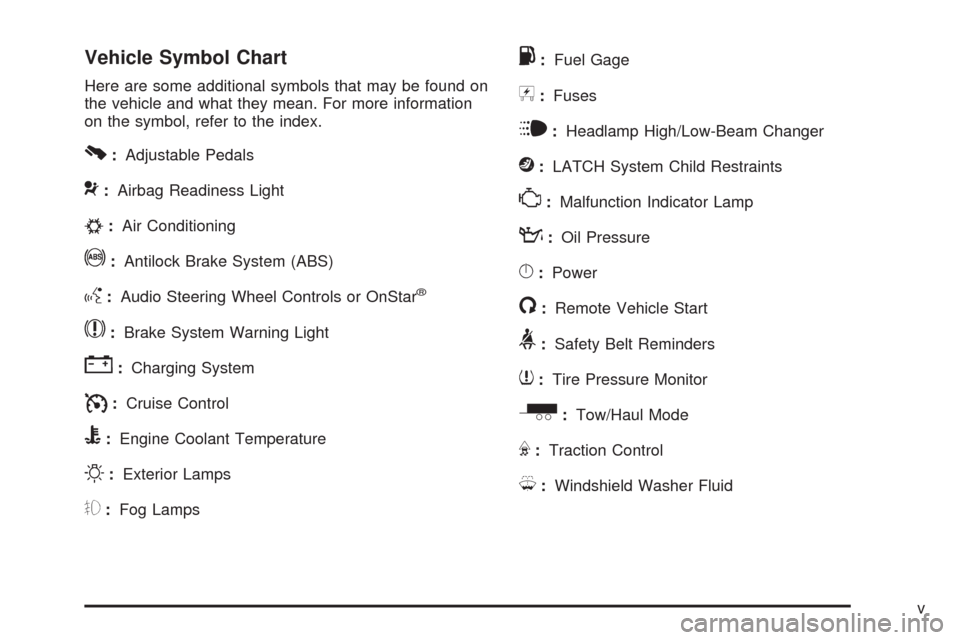
Vehicle Symbol Chart
Here are some additional symbols that may be found on
the vehicle and what they mean. For more information
on the symbol, refer to the index.
0:Adjustable Pedals
9:Airbag Readiness Light
#:Air Conditioning
!:Antilock Brake System (ABS)
g:Audio Steering Wheel Controls or OnStar®
$:Brake System Warning Light
":Charging System
I:Cruise Control
B:Engine Coolant Temperature
O:Exterior Lamps
#:Fog Lamps
.:Fuel Gage
+:Fuses
i:Headlamp High/Low-Beam Changer
j:LATCH System Child Restraints
*:Malfunction Indicator Lamp
::Oil Pressure
}:Power
/:Remote Vehicle Start
>:Safety Belt Reminders
7:Tire Pressure Monitor
_:Tow/Haul Mode
F:Traction Control
M:Windshield Washer Fluid
v
Page 7 of 442

Front Seats......................................................1-2
Manual Seats................................................1-2
Power Seats..................................................1-3
Power Lumbar ...............................................1-4
Heated Seats.................................................1-4
Memory Seat and Mirrors................................1-5
Reclining Seatbacks........................................1-6
Head Restraints.............................................1-9
Rear Seats.....................................................1-11
Rear Seat Operation.....................................1-11
Stowable Seat..............................................1-12
Safety Belts...................................................1-13
Safety Belts: They Are for Everyone................1-13
How to Wear Safety Belts Properly.................1-18
Lap-Shoulder Belt.........................................1-27
Safety Belt Use During Pregnancy..................1-32
Safety Belt Extender.....................................1-32
Child Restraints.............................................1-33
Older Children..............................................1-33
Infants and Young Children............................1-36
Child Restraint Systems.................................1-39Where to Put the Restraint.............................1-42
Lower Anchors and Tethers for
Children (LATCH)......................................1-43
Securing a Child Restraint in a
Rear Seat Position....................................1-49
Securing a Child Restraint in the
Right Front Seat Position............................1-52
Airbag System...............................................1-56
Where Are the Airbags?................................1-58
When Should an Airbag In�ate?.....................1-61
What Makes an Airbag In�ate?.......................1-63
How Does an Airbag Restrain?.......................1-63
What Will You See After an Airbag In�ates?.....1-64
Passenger Sensing System............................1-65
Servicing Your Airbag-Equipped Vehicle...........1-70
Adding Equipment to Your
Airbag-Equipped Vehicle.............................1-70
Restraint System Check..................................1-72
Checking the Restraint Systems......................1-72
Replacing Restraint System Parts
After a Crash............................................1-73
Section 1 Seats and Restraint System
1-1
Page 14 of 442
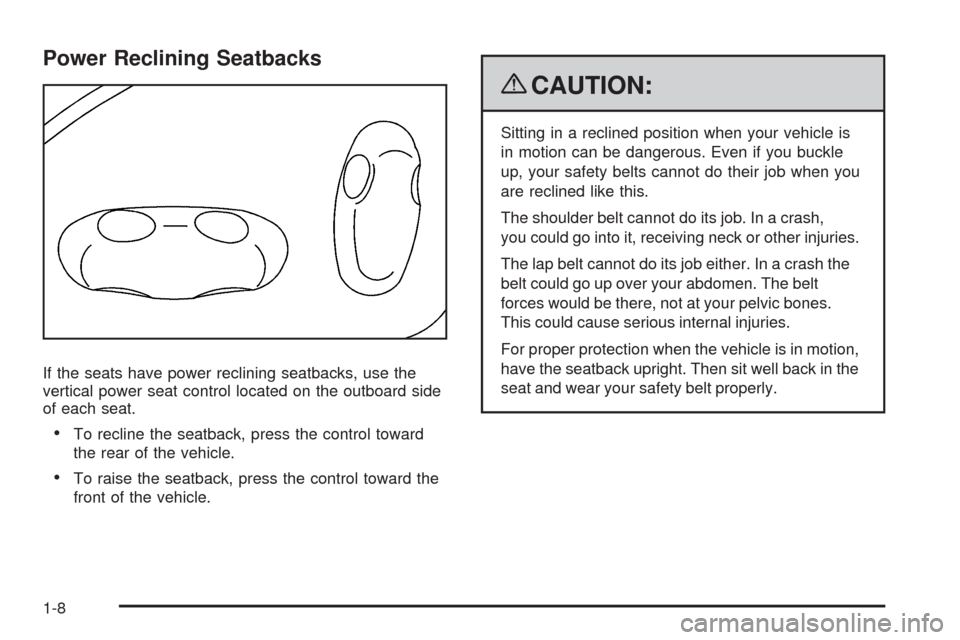
Power Reclining Seatbacks
If the seats have power reclining seatbacks, use the
vertical power seat control located on the outboard side
of each seat.
To recline the seatback, press the control toward
the rear of the vehicle.
To raise the seatback, press the control toward the
front of the vehicle.
{CAUTION:
Sitting in a reclined position when your vehicle is
in motion can be dangerous. Even if you buckle
up, your safety belts cannot do their job when you
are reclined like this.
The shoulder belt cannot do its job. In a crash,
you could go into it, receiving neck or other injuries.
The lap belt cannot do its job either. In a crash the
belt could go up over your abdomen. The belt
forces would be there, not at your pelvic bones.
This could cause serious internal injuries.
For proper protection when the vehicle is in motion,
have the seatback upright. Then sit well back in the
seat and wear your safety belt properly.
1-8
Page 17 of 442
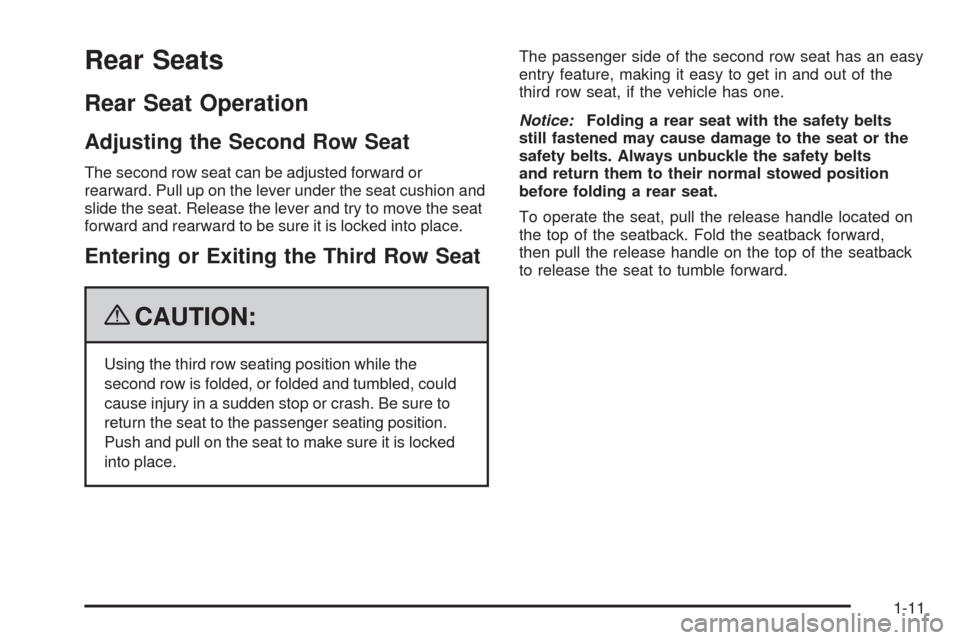
Rear Seats
Rear Seat Operation
Adjusting the Second Row Seat
The second row seat can be adjusted forward or
rearward. Pull up on the lever under the seat cushion and
slide the seat. Release the lever and try to move the seat
forward and rearward to be sure it is locked into place.
Entering or Exiting the Third Row Seat
{CAUTION:
Using the third row seating position while the
second row is folded, or folded and tumbled, could
cause injury in a sudden stop or crash. Be sure to
return the seat to the passenger seating position.
Push and pull on the seat to make sure it is locked
into place.The passenger side of the second row seat has an easy
entry feature, making it easy to get in and out of the
third row seat, if the vehicle has one.
Notice:Folding a rear seat with the safety belts
still fastened may cause damage to the seat or the
safety belts. Always unbuckle the safety belts
and return them to their normal stowed position
before folding a rear seat.
To operate the seat, pull the release handle located on
the top of the seatback. Fold the seatback forward,
then pull the release handle on the top of the seatback
to release the seat to tumble forward.
1-11
Page 18 of 442
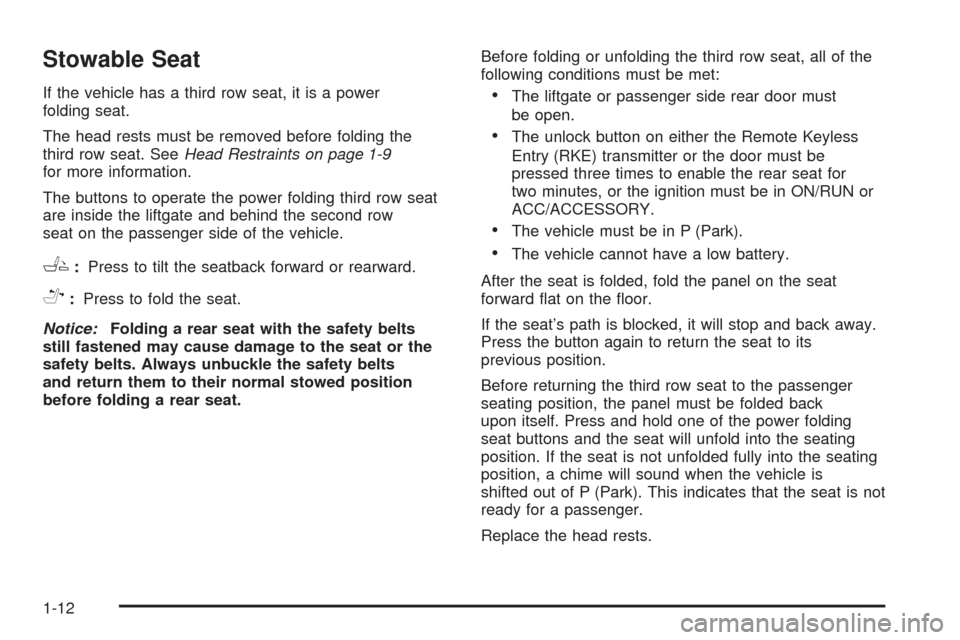
Stowable Seat
If the vehicle has a third row seat, it is a power
folding seat.
The head rests must be removed before folding the
third row seat. SeeHead Restraints on page 1-9
for more information.
The buttons to operate the power folding third row seat
are inside the liftgate and behind the second row
seat on the passenger side of the vehicle.
e:Press to tilt the seatback forward or rearward.
f:Press to fold the seat.
Notice:Folding a rear seat with the safety belts
still fastened may cause damage to the seat or the
safety belts. Always unbuckle the safety belts
and return them to their normal stowed position
before folding a rear seat.Before folding or unfolding the third row seat, all of the
following conditions must be met:
The liftgate or passenger side rear door must
be open.
The unlock button on either the Remote Keyless
Entry (RKE) transmitter or the door must be
pressed three times to enable the rear seat for
two minutes, or the ignition must be in ON/RUN or
ACC/ACCESSORY.
The vehicle must be in P (Park).
The vehicle cannot have a low battery.
After the seat is folded, fold the panel on the seat
forward �at on the �oor.
If the seat’s path is blocked, it will stop and back away.
Press the button again to return the seat to its
previous position.
Before returning the third row seat to the passenger
seating position, the panel must be folded back
upon itself. Press and hold one of the power folding
seat buttons and the seat will unfold into the seating
position. If the seat is not unfolded fully into the seating
position, a chime will sound when the vehicle is
shifted out of P (Park). This indicates that the seat is not
ready for a passenger.
Replace the head rests.
1-12
Page 19 of 442
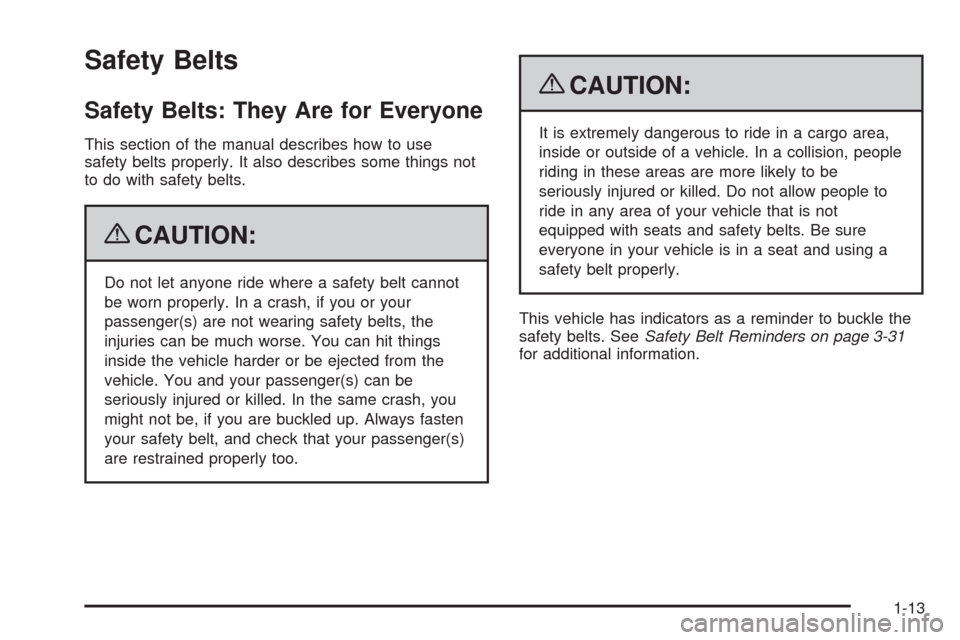
Safety Belts
Safety Belts: They Are for Everyone
This section of the manual describes how to use
safety belts properly. It also describes some things not
to do with safety belts.
{CAUTION:
Do not let anyone ride where a safety belt cannot
be worn properly. In a crash, if you or your
passenger(s) are not wearing safety belts, the
injuries can be much worse. You can hit things
inside the vehicle harder or be ejected from the
vehicle. You and your passenger(s) can be
seriously injured or killed. In the same crash, you
might not be, if you are buckled up. Always fasten
your safety belt, and check that your passenger(s)
are restrained properly too.
{CAUTION:
It is extremely dangerous to ride in a cargo area,
inside or outside of a vehicle. In a collision, people
riding in these areas are more likely to be
seriously injured or killed. Do not allow people to
ride in any area of your vehicle that is not
equipped with seats and safety belts. Be sure
everyone in your vehicle is in a seat and using a
safety belt properly.
This vehicle has indicators as a reminder to buckle the
safety belts. SeeSafety Belt Reminders on page 3-31
for additional information.
1-13
Page 20 of 442

In most states and in all Canadian provinces, the law
requires wearing safety belts. Here is why:
You never know if you will be in a crash. If you do have
a crash, you do not know if it will be a serious one.
A few crashes are mild, and some crashes can be so
serious that even buckled up, a person would not
survive. But most crashes are in between. In many of
them, people who buckle up can survive and sometimes
walk away. Without safety belts, they could have
been badly hurt or killed.
After more than 40 years of safety belts in vehicles,
the facts are clear. In most crashes buckling up does
matter... a lot!Why Safety Belts Work
When you ride in or on anything, you go as fast as
it goes.
Take the simplest vehicle. Suppose it is just a seat
on wheels.
1-14
Page 23 of 442
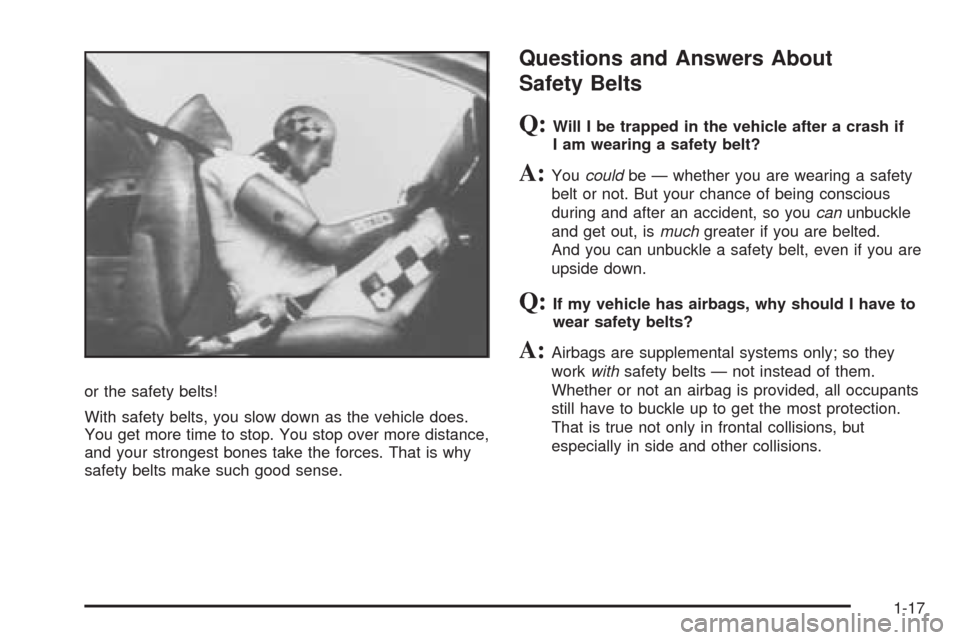
or the safety belts!
With safety belts, you slow down as the vehicle does.
You get more time to stop. You stop over more distance,
and your strongest bones take the forces. That is why
safety belts make such good sense.
Questions and Answers About
Safety Belts
Q:Will I be trapped in the vehicle after a crash if
I am wearing a safety belt?
A:Youcouldbe — whether you are wearing a safety
belt or not. But your chance of being conscious
during and after an accident, so youcanunbuckle
and get out, ismuchgreater if you are belted.
And you can unbuckle a safety belt, even if you are
upside down.
Q:If my vehicle has airbags, why should I have to
wear safety belts?
A:Airbags are supplemental systems only; so they
workwithsafety belts — not instead of them.
Whether or not an airbag is provided, all occupants
still have to buckle up to get the most protection.
That is true not only in frontal collisions, but
especially in side and other collisions.
1-17
Page 24 of 442
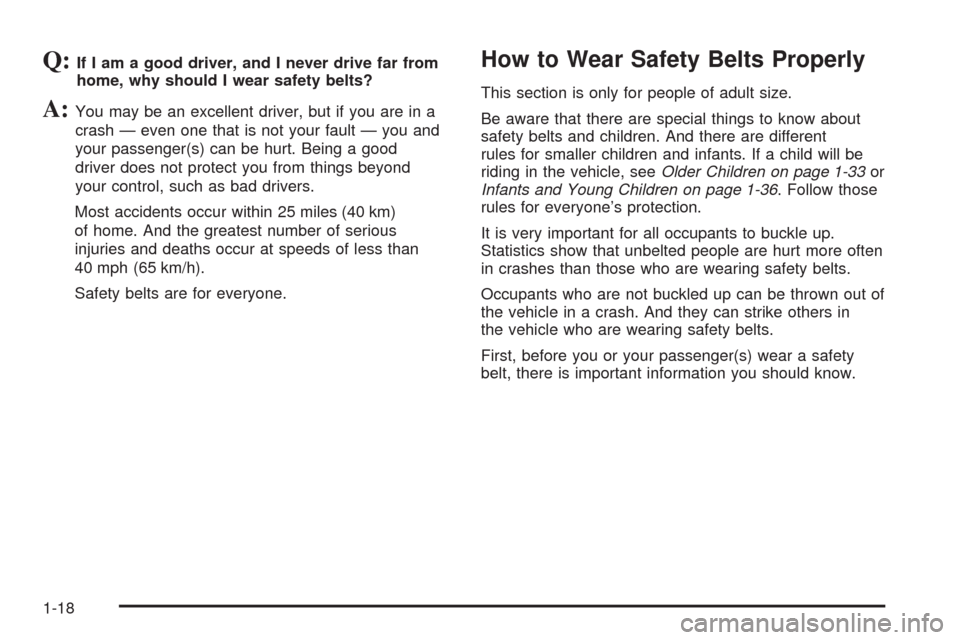
Q:If I am a good driver, and I never drive far from
home, why should I wear safety belts?
A:You may be an excellent driver, but if you are in a
crash — even one that is not your fault — you and
your passenger(s) can be hurt. Being a good
driver does not protect you from things beyond
your control, such as bad drivers.
Most accidents occur within 25 miles (40 km)
of home. And the greatest number of serious
injuries and deaths occur at speeds of less than
40 mph (65 km/h).
Safety belts are for everyone.
How to Wear Safety Belts Properly
This section is only for people of adult size.
Be aware that there are special things to know about
safety belts and children. And there are different
rules for smaller children and infants. If a child will be
riding in the vehicle, seeOlder Children on page 1-33or
Infants and Young Children on page 1-36. Follow those
rules for everyone’s protection.
It is very important for all occupants to buckle up.
Statistics show that unbelted people are hurt more often
in crashes than those who are wearing safety belts.
Occupants who are not buckled up can be thrown out of
the vehicle in a crash. And they can strike others in
the vehicle who are wearing safety belts.
First, before you or your passenger(s) wear a safety
belt, there is important information you should know.
1-18